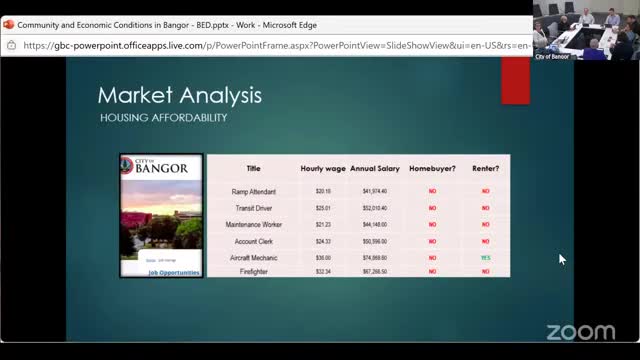Bangor Chamber Unveils Job Market Challenges Amid Rising Housing Costs
August 18, 2025 | Bangor City, Penobscot County, Maine
This article was created by AI summarizing key points discussed. AI makes mistakes, so for full details and context, please refer to the video of the full meeting. Please report any errors so we can fix them. Report an error »

In the heart of Bangor, Maine, city officials gathered to address pressing economic challenges that residents face in their pursuit of affordable housing. The meeting, held on August 18, 2025, revealed a stark reality: many local jobs do not offer the salaries necessary for individuals to afford homes in the area.
As discussions unfolded, it became clear that while certain professions, such as aircraft mechanics, can manage to rent apartments, the dream of homeownership remains elusive for many. The average salary for various occupations in Bangor was scrutinized, highlighting a troubling trend where even well-paying jobs struggle to keep pace with rising housing costs. For instance, the average salary for sales positions was noted to be particularly low, reflecting a disparity that could hinder recruitment efforts across multiple sectors.
The Bangor Chamber of Commerce presented data indicating that the city’s economic landscape is heavily influenced by five key sectors: healthcare, education, tourism, retail, and manufacturing. With over 15,000 employees in healthcare alone, driven by a growing senior population, this sector stands as a pillar of the local economy. Education also plays a significant role, employing nearly 10,000 individuals, thanks to institutions like Husson University.
Retail trade, featuring major employers like Hannaford and Walmart, employs more than 10,500 people, many of whom commute from outside Bangor. This reliance on external workers raises questions about the local economy's sustainability and the need for better job opportunities that cater to residents.
Manufacturing, particularly in aerospace and wood products, is another area of focus. The state of Maine is actively investing in innovation within these industries, aiming to create stable employment opportunities. However, the challenge remains: how can Bangor harness this growth to improve housing availability and affordability?
Tourism and hospitality emerged as a potential avenue for economic development, with Bangor's proximity to attractions like Acadia National Park and its status as a concert destination. The Maine Savings Amphitheater, boasting a capacity of 17,500, serves as a significant draw for visitors and could help bolster the local economy.
As the meeting concluded, the city council recognized the urgent need for strategic planning to address these economic disparities. The discussions underscored a collective commitment to fostering a vibrant community where residents can thrive, not just survive. The path forward will require collaboration among various sectors to ensure that Bangor remains a place where families can afford to call home.
As discussions unfolded, it became clear that while certain professions, such as aircraft mechanics, can manage to rent apartments, the dream of homeownership remains elusive for many. The average salary for various occupations in Bangor was scrutinized, highlighting a troubling trend where even well-paying jobs struggle to keep pace with rising housing costs. For instance, the average salary for sales positions was noted to be particularly low, reflecting a disparity that could hinder recruitment efforts across multiple sectors.
The Bangor Chamber of Commerce presented data indicating that the city’s economic landscape is heavily influenced by five key sectors: healthcare, education, tourism, retail, and manufacturing. With over 15,000 employees in healthcare alone, driven by a growing senior population, this sector stands as a pillar of the local economy. Education also plays a significant role, employing nearly 10,000 individuals, thanks to institutions like Husson University.
Retail trade, featuring major employers like Hannaford and Walmart, employs more than 10,500 people, many of whom commute from outside Bangor. This reliance on external workers raises questions about the local economy's sustainability and the need for better job opportunities that cater to residents.
Manufacturing, particularly in aerospace and wood products, is another area of focus. The state of Maine is actively investing in innovation within these industries, aiming to create stable employment opportunities. However, the challenge remains: how can Bangor harness this growth to improve housing availability and affordability?
Tourism and hospitality emerged as a potential avenue for economic development, with Bangor's proximity to attractions like Acadia National Park and its status as a concert destination. The Maine Savings Amphitheater, boasting a capacity of 17,500, serves as a significant draw for visitors and could help bolster the local economy.
As the meeting concluded, the city council recognized the urgent need for strategic planning to address these economic disparities. The discussions underscored a collective commitment to fostering a vibrant community where residents can thrive, not just survive. The path forward will require collaboration among various sectors to ensure that Bangor remains a place where families can afford to call home.
View full meeting
This article is based on a recent meeting—watch the full video and explore the complete transcript for deeper insights into the discussion.
View full meeting
